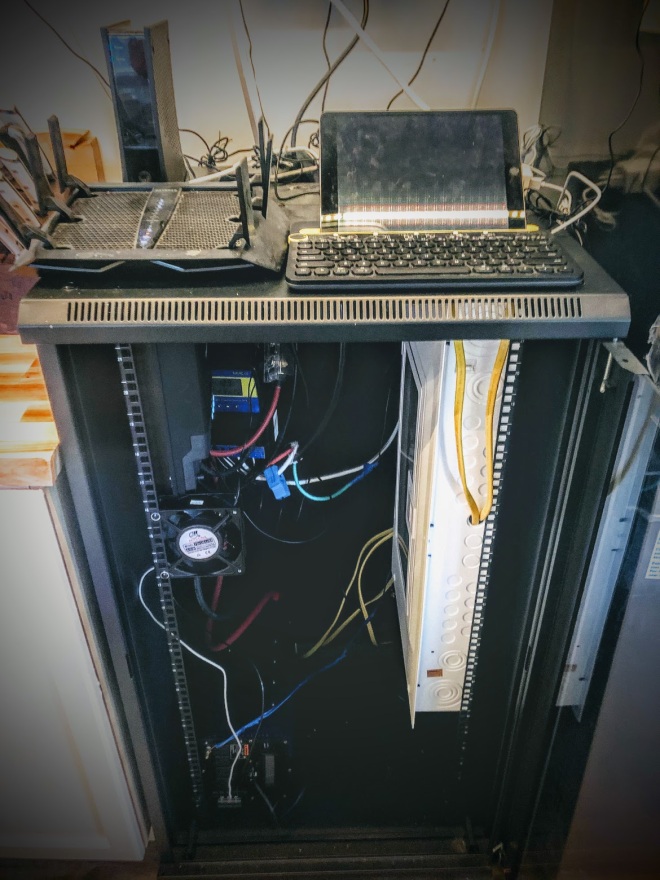While we were designing the Airstream, one of the requirements we wanted to achieve was a completely electric-based ecosystem; basically, zero propane or gasoline. We wanted to do this to essentially:
1. Prove that it’s possible
2. Reduce our overall environmental impact
3. Figure out how to do it efficiently
Three months into the project, we’ve developed a pretty unique full-stack energy system using off-the-shelf products easily available online. What we mean by “full-stack energy system” is a complete energy solution with energy generation, energy storage, energy conversion, and energy consumption capabilities. The cherry on top is we fit the core of our energy system is in a single enclosure, which we now dub the “Energy Box”
Due to the wide array of product availability out there, each component of a full-stack energy system is customize-able, however, to give you an idea of what a system could look like, here is our complete build [click for full size]:
We chose this build after considering costs, quality, warranties, energy availability (Texas gets a lot of sun), device efficiencies, smart/wifi capabilities, and other unique attributes we’ll explain in these breakout sections:
Energy Generation
*Solar Panels: Renogy 12V 160W Flexible Solar Panels (2)
-Product Description: https://amz.run/3GHf
-Pros: High power solar panels for size, highly flexible to mold to our Airstream’s rounded roof
-Cons: High cost due to extreme flexibility
*Charge Controller: Renogy Rover 60A MPPT Charge Controller
-Product Description: https://amz.run/3GHe
-Pros: Maximum Power Point Tracking (MPPT) Charge Controller to optimize solar energy charging into battery array, great cost for amount of features, high compatibility with Lithium batteries
-Cons: Lack of smart features; no wifi or pc data offload capabilities
Energy Storage
*Batteries: Renogy 12V 100Ah Lithium Iron Phosophate Smart Batteries (3)
-Product Description: https://amz.run/3GHb
-Pros: Battery management system integrated smart battery with a lot of usable energy (100Ah each), lithium iron phosphate batteries are an INCREDIBLE modern battery technology; they’re extremely safe, 99% efficient, and last 10-15 years
-Cons: Ouch… my wallet hurts after buying three of these to build a 300Ah array… Batteries are by far the most expensive component of a full-stack energy system
Energy Conversion
*Inverter: VOLTWORKS 12V 3000W Pure Sine Wave Inverter
-Product Description: https://amz.run/3GHY
-Pros: 3000 watts of continuous pure sine wave AC power with 6000W surge capabilities; this converts stored DC energy to AC energy (the energy our home appliances use), 18-month warranty
-Cons: Like any inverter – drains the battery while it’s on (90% efficiency)
Energy Consumption
*Load Center: Leviton Smart Load Center
-Product Description: https://amz.run/3GGy
-Pros: Smart load center system, top electricity safety features, easy to install/configure/upgrade
-Cons: Costs more than traditional load centers, can only use Leviton brand Circuit Breakers
*Circuit Breakers: Leviton 20A GFCI/AFCI Smart Circuit Breakers (6)
-Product Description: https://www.leviton.com/en/products/residential/load-centers/the-leviton-smart-load-center
-Pros: Integrated smart features, top industry safety features, easy to install
-Cons: Smart Breakers not available from Amazon; must be bought from distributor, more expensive than regular breakers
*Power Strips: TP-Link 6-Outlet Smart Power Strip (6)
-Product Description: https://amz.run/3GHa
-Pros: Smart live energy usage features, looks great, easy to setup/configure/use
-Cons: Pretty costly for a 6-outlet power strip
Accessories:
*Copper Wire: Romex indoor 12/2 solid copper wire w/ground (100ft)
-Product Description: https://amz.run/3GGh
-Pros: Cost effective for length
-Cons: None.. pretty standard stuff..
*Wall Outlets: Leviton 15A Wall Outlets (5)
-Product Description: https://amz.run/3GHK
-Pros: High quality for low cost
-Cons: Wish they had a variety-pack of 15A and 20A
*Automatic Transfer Switch: MOES 50A Grid/Inverter/Load Center ATS
-Product Description: https://amz.run/3GGl
-Pros: Automatically and seamlessly switches to grid power when batteries voltage is lower than cut off point – will switch back to battery power when the batteries voltage is higher than recovery point, low cost for functionality
-Cons: No longer on Amazon for some reason, no integrated smart features
*Fuses: 50A ANL Fuses
-Product Description: https://amz.run/3GHH
-Pros: Great price, high quality, looks good
-Cons: None.. pretty standard item
*Enclosure: Navepoint 22U Server Rack
-Product Description: https://amz.run/3GHD
-Pros: Great price for server rack size and included equipment, glass front looks great
-Cons: Cheap metal that bends pretty easily
So that’s it; the full recipe for a a complete energy system. There’s no other mystery behind it other than making sure you follow each products’ instructions, look stuff up on the internet or rely on customer service when you have questions, and you’re comfortable being diligent through tedium (time to bend another wire just right…fuck my fingers, I guess) and series of mistakes (So why is the thing still not turning on… is it because it’s covered with tears of my seemingly endless sorrow?).
If you’re going to try something like this, have some ideas on how to optimize, or know some other folks doing stuff like this, I’d love to hear from you.
Wish ya’ll the best through the journey of continuous learning 🙂
-Eddie
P.S. As a result of this learning experience, we were able to create some pretty awesome energy system intelligence systems [see below] using completely free open-source platforms. These came about pretty naturally since we wanted a complete picture of our energy system data – everything from the solar panel to the battery to the appliance. More to come in future posts on those systems 🙂


